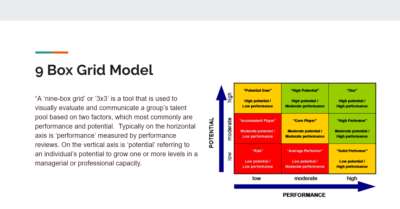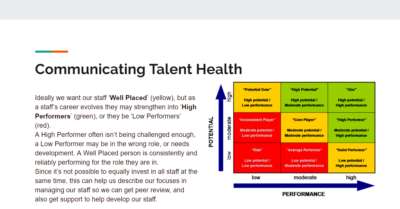Employee Performance Calibration Process
A guide for a simple scalable way to regularly communicate and discuss a talent pool within a company.
talent management agile org design organizational modelsBlog Post: https://alexwitherspoon.com/publications/employee-performance-calibration-process/
Open Source Repo: https://github.com/alexwitherspoon/employee-performance-calibration-process

Link to Presentation Template: Slides
Overview
Each organization will build it’s own philosophy for how to measure success that is hopefully relevant and useful. When those evaluations happen, one of the worst things that can happen after performance reviews, or goal setting, is to miss the opportunity to do something with that information. So you have a high performing person, now what? - That person needs just as much attention and thought from their manager as someone who is under performing does, or the opportunity is not fully being realized. If you are a manager of people, consider using this tool directly, or as the basis for your own aproach. If you are not a manager of people - you can still use this tool more directly for yourself to think of how you want to manage your career, and how it is perceived, and intentionally developed.
So how does this happen? - I’ve found that many companies don’t communicate, or don’t communicate in a timely fashion the current lay of the land for the staff they manage. So let’s look at one lightweight free process that you can use today to help bridge this gap.
TL:DR - Next Steps
Take the presentation template, make a copy for yourself, and fill it out at least quarterly. Review it with your boss, and someone from HR. If your boss is ok with it, review this with direct people managing peers with the boss and HR present. This is a great way to have any discussions that need to happen regularly, and help get attention and focus to the right people at the right time. DO NOT use this as a way to punish, or push an agenda against others, this tool is powerful when used constructively, and it can be used to reinforce or create unhelpful or destructive outcomes.
Goals
- Provide a structured aproach for discussing staff amongst management and HR.
- Honestly and accurately describe your professional observations and opinions about your direct staff in writing.
- Organize the conversation so that effective peer review and support can take place.
- Ensure this information is cascaded upwards so leadership can understand how to best support staff.
- Invite different perspectives to discuss employees so we get a more complete view.
- Reduce the risk of a ‘bad manager’ impacting employees poorly without oversight.
- Help bring more consistent conversations about applying the philosophies of the company like leveling, roles, and expectations to real examples to help support, or better understand how to manage individuals.
Key Concepts
Summarize Performance and Potential

To help make the conversation effective, we need to categorize in a broad sense our staff into these nine squares. This 9 squares, or 3x3 grid allows us to think about our staff as measured against two very important categories of Potential, and Performance when considering talent management conversations.
How to Think about this Grid

When thinking about this scale, it’s easy for someone to say, well I always want to be a “Star” or High Potential and High Performing all the time! While this is possible, it should be rare in the sense that if someone is consistently and constantly performing above all expectations - they are likely in the wrong role or level. - Some intentional career planning needs to take place here to understand where this individual wants to be, and how to help align that with company goals, or even prepare for an eventual departure of the company if this individual can’t be kept content with the challenge of the work.
Likewise, the low performing, low potential category is especially important to focus on, as this individual is likely in the wrong role, or needs intentional career development conversations to help understand how to make them successful.
The equilibrium in a sense, exists in the ‘Well Placed’ category, or the yellow middle between low, and high performance and potential. - This is a place where the person is performing well, reliably, and consistently, while still feeling challenged, and still growing their career. Put simply, they are equally challenged and performing. It’s important to remember that a individual’s career is not static, and it changes over time, so staff will change, and this idea of a happy middle is more conceptual than a reality. It’s only useful in the sense that it helps us focus our attention and our efforts towards the outliers for a given time period.
Also - keep in mind that a great employee may move between these categories naturally as they Storm/Norm/Form. The focus shouldn’t be judgmental or punitive around the current perceived state of an employee, the focus should be on verifying the validity of the observations of the manager, and the action plan to help the employee succeed. The very best employee is the one we correctly invest in, and place in the right environment to succeed at the right times.
Tell a Human Story

To really make this happen, we list out the staff in each category, and then we highlight and focus on describing the staff simply and effectively in the slide deck. This is the foundational information for a conversation to help determine the best actions to take with a person, such as confirming they are ready for a promotion, or that a performance improvement plan makes sense. This conversation by it’s nature needs to be held confidentially, and with support of HR to make sure it’s facilitated well. When this is used properly, it allows for frequent honest conversation about how staff are doing, how to support them better, and help advocate and evangelize them when it makes sense to do so with leadership.
Filling out these slides initially is hard work, but a tip to help with this workload is that after filling them out - try whenever possible to modify them over time and avoid complete rewrites of the slides unless needed. These words and observations should evolve with the human they are describing rather than be completely rewritten at every instance of review. Speaking for myself, I typically visit these slides once a week for 30 minutes or so and ask “Is this still accurate, have my views changed, and why?” - If there are changes I either make them to the slides, or take note of them for more reflection later. These notes are incresibly useful to help understand how someone is evolving over time, and what I am noticing about them.
Bias and Calibration
Lastly I want to discuss ‘Bias’ and ‘Calibration’. Bias is the accumulation of observations and thoughts which are typically pre-assembled and convenient to help assess a situation. - Without bias, we as humans would be extremely limited in our ability to do great things because we would have to carry the mental burden of constantly evaluating our entire human experience as we experience it in a reactionary fashion - and we simply are not capable of that. It’s a human limitation, and something we need to confront and be aware of. Calibration in this context can be thought of as the reconciliation of a series of biases between one another. An instrument such as a ruler carries a bias for it’s specific interpretation of distance, which can be calibrated between a set of rulers to create common understanding, and so too with humans we can compare and contrast our biases to come to common understandings as well.
Bias is often talked about as something to avoid, or in the sense of ‘removing it’, but the reality is that we cannot remove bias, it’s part of our entire human experience, it’s part of how our biology functions. Even if we write software to ‘remove bias’ studies show we are just encoding our biases into the software we write. - Much of our biases can be harmless, or helpful even, so we can focus on more important, changing or new details. What is harmful in almost all cases however, are biases which go unchecked, and are not reviewed from time to time.
The easiest way to make sure we check our biases, especially when it comes to managing people, is to confront our biases regularly. We can’t be in fear of them, but we need to check them, and make sure the biases we carry are helpful, honest, correct, and useful. If a bias is harmful, we should correct it, and similarly if it not useful, it should be cast aside. Perfectly reasonable and helpful biases can become unhelpful, and unreasonable over time as we learn more, and as things change. Bringing different people and perspectives into a conversation about biases often immediately helps check and enhance our biases to be better. We should be willing to regularly assess our biases, and not focus simply on removing them. From a scientific standpoint, we want to ensure we utilize our capacity for neural plasticity to our advantage as much as possible.
I stress this concept because the process above is meant to help create a regular cadence to explore our biases as people managers, in a supportive and safe space so we can make these adjustments, corrections, and learnings in a proactive fashion. Make sure there is time set aside for this discussion so it can foster alignment, understanding, learning and ultimately help us better manage our staff.